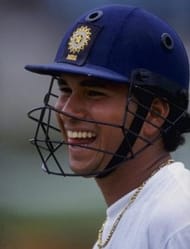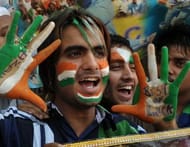Rewind to 1991 – The then Finance Minister, Dr. Manmohan Singh went on to launch the landmark, economic liberalization of India after the country sold 67 tons of gold to International Monetary Fund. It was in the same year that, LTTE assassinated India’s Prime Minister, Dr. Rajiv Gandhi. Operation Desert Storm had marked the beginning of the “Gulf War” with air strikes against Iraq. Yugoslavia had collapsed. Croatia and Slovenia, declared their independence. Amitabh Bachchan and Rajinikanth were in their prime as “Hum” was declared one of the biggest box-office Bollywood hits of that year. Tim Berners Lee had only then announced the World Wide Web project!
In a corner of the world called Perth, the teenager in Sachin Tendulkar scored, what is probably his best test hundred till date. The hundred was a template of sorts for years to come. Sachin Tendulkar, literally typified, India’s chances in every game they played in the 90s. Despite another ten cricketers forming the team with Tendulkar, the 20-year old carried the baton for a decade with his willow, all alone.

Tendulkar used to sporadically spark happiness among his countrymen with some high-class centuries. The game, for millions, started and ended with Sachin Ramesh Tendulkar.
Sachin Tendulkar remained the only batsman in the Indian lineup who could really take on the opposition and administer the proceedings. That showed with the results too. An individual can hardly win you every game. While the batsmen and spinners showed they are tigers at home, they languished as poor tourists throughout the 90s scared of the bouncy and swinging conditions. Tendulkar used to sporadically spark happiness among his countrymen with some high-class centuries. The game, for millions, started and ended with Sachin Ramesh Tendulkar.
As a cricketing nation, the team didn’t own too many inspirational and encouraging leaders in their arsenal. Through the 90s, the mantle moved on from Mohammed Azharuddin to Sachin Tendulkar to Ajay Jadeja to Sachin Tendulkar and then, once again to Mohammed Azharuddin. The country didn’t have leaders to look for and hence, the role of captaincy kept switching between the top batsmen in the country. The leadership qualities were hardly tested before giving them a job. However, Azharuddin did a remarkable job with the team by not losing a single test series in home throughout the 90s.
With Warrior Prince, Sourav Ganguly turning up as the new leader in 2000, the country matured to register important test wins with its golden generation of cricketers. The signs of confidence with young India showed off with the brand of cricket the team started to play especially in tough alien conditions. The emergence of MS Dhoni as wicket keeper – captain has been the icing on the cake for Indian cricket.
Five World Cups before the 2011 edition and Tendulkar could hardly get a hand on the trophy! The way the team evolved cannot be told better than this story. Disappointments loomed large since ’92 at every World Cup for the Master Blaster. The ’96 mortification at home (despite Sachin’s heroics) was followed by despondency at the final post in Jo’Burg 2003. The 2007 edition saw the team touch a new low, an unexpected downfall. Later, with Dhoni at the helm, India’s youngsters started to regroup once again as a team and showed the world that they can win without the services of Tendulkar in a big World Cup Final. That moment marked the culmination of the successful evolution of a team which once relied on Tendulkar’s batting fortunes to win a game of cricket.
The grand economic liberalization was in full swing in the 90s and money started to pour in the game slowly with the Cola companies. “With the spread of television and the growing integration of India into the world market, cricket has successfully consummated its marriage with consumer capitalism. The makers of chocolates and ice-creams and refrigerators and whisky all choose top cricketers to model for and market their products” says Ramachandra Guha in his widely appreciated book, A Corner of a Foreign Field.
Indian teams which were earlier dominated by players from big towns and cities like Mumbai, Delhi, Bangalore, Pune, Chandigarh and Chennai, now had players from Srirampur, Cuttack, Lucknow, Baroda, Ranchi, Kothamangalam and much more. In many ways, the infusion of players from little known cricketing centers into the national set up helped the country slowly get away from the clutches of biased selections also. The fiscal ascension of India as a whole has to be the only reason for such an evolution. Cricket was no more perceived as a risky career.
The economic-boom witnessed a spectacular rise in Indian cricketers’ income. While there were days when Indian test players were paid Rs.50 per test match, the late nineties saw the cricketers earn close to 100,000/- every day. Sachin Tendulkar remained the highest paid sportsman in India for a long time. Now that Dhoni has overtook him like a storm, gives us more than a hint about how much capital is in the system now. The Board of Control for Cricket in India which was earlier earning 2 crore rupees a year, started earning close to 300 crores every year. With every passing year now cricket in India, financially, is growing like a dangerous giant waiting to eat up the whole world with its incredible power. Former England captain, Tony Greig recently went on to say that he is waiting to see India’s reign to end in ICC as they are heavily influencing the decisions totally based on the finances.
Greig’s fear can be plainly put upon the Indian Premier League that has taken world cricket by storm. Domestic cricket has never been so rewarding. Twenty 20 cricket has been viewed as the best way to make money out of the game like never before. Earlier, cricket as a career was viewed as high risk and middle-class families would hardly allow budding cricketers to take the sport as a means to win bread. The perception towards CRICKET – THE PROFESSION has definitely changed with the advent of T20. Every state association now has a league of its own that pays zonal level cricketers handsomely. So, all it means is, you really don’t have to sweat out to earn big bucks. While an India cap is still elusive and the ultimate pride, quick wealth can be amassed to save lives by playing local T20 tournaments that’s growing like mushrooms in rain every day.
It sounds really weird, but the truth is, there was a time in history when international cricketers made efforts to skip India tours. At this point in time, it is almost inconceivable for players to skip India tours.
The nineties were also a time in history when professionalism was totally irrelevant in the whole picture for the support staff and administrators in the game. Twenty years ago, world class stadiums was something an average Indian cricket fan can yearn for, can dream for. Today, the funds have ensured that the spectator gets a bucket seat to watch the game comfortably. Nagpur, Mumbai, Chennai, Hyderabad and Kolkata have got refurbished stadiums that on any day challenge some of the best maintained cricket stadiums in the world. The country now has full time paid selectors who are accountable for their job. There is a video analyst, physio, trainer and assistant coaches for each skill in the game. With Duncan Fletcher now in the hot seat, Indian cricket has now seen four foreign coaches to have taken the game to the next level. Talk about Foreign Direct Investments! Wright remarked the amount of professionalism he saw in the national players, when he first signed up as the coach in his book – Indian Summers. With no uniform jerseys, cushion chairs around the nets area and waiters with tea in the gym, the players looked more like princes on vacation rather than sportsmen who are a part of an international unit.

When Wright took over he found the team had no uniform jerseys, cushion chairs around the nets area and waiters with tea in the gym. The players looked more like princes on vacation rather than sportsmen who are a part of an international unit.
2011 as I see, Cricket is a zillion dollar industry that grows exponentially every year in India. None would have imagined to see three TV channels dedicated completely for cricket, say even five years ago! Broadcasters know that cricket sells in a gargantuan manner here and hence keep feeding the audience with unlimited amount of cricket. The Board, in its part, has tour programmes planned with absolutely no breaks for the big-dollar earning demi gods. Indian cricket today, reminds me of the famous golden goose fable once told by Avianus and Caxton. The impression the administrators of the game in India give is that their greed to earn more dollars in growing incessantly. The day is not so far off when they would attempt to kill the goose to get all the golden eggs!
When the ’96 World Cup came home, four hundred million people watched the matches. Rohit Brijnath, an India Today journalist covering the show breathlessly captured the impact of it all: “In Calcutta paras, youngsters hurl themselves across the concrete earning sobriquets like Jonty-da. Employers peer at sheaves of leave forms and don’t wonder why. At street corners, motorcycles are being bartered for tickets. Firecrackers, stores from Diwali, are sold at premium. Exams are arriving, but Newton’s Third Law of Motion must make way for an examination of Wasim Akram’s strike rate. Fathers start pontificating about the ‘good old days’ of Test cricket, while mothers keep asking what a Chinaman is doing on the field. Cricket anyone? Make that everyone.”
Fifteen years since, the team, the administration, the players and the economics might have evolved for the goodness and at times, for the evilness of the sport. But, deep down the heart, the love for the game of cricket in every Indian is still the same. It is a sweet romance that will never die down, come what may in its way.
Looking for fast live cricket scores? Download CricRocket and get fast score updates, top-notch commentary in-depth match stats & much more! 🚀☄️


